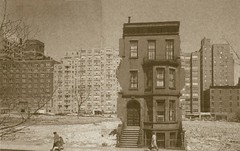Obituary, Evelyn Ortner, (Brooklyn) Brownstone Revival Coalition
 Brownstone Awaiting A Wrecking Ball, NYC 1959, by Dmitri Kessel, from the Brownstone Revival Coalition website.
Brownstone Awaiting A Wrecking Ball, NYC 1959, by Dmitri Kessel, from the Brownstone Revival Coalition website.
I am behind in reading the New York Times, so I missed this obituary from Friday 9/22, "Evelyn Ortner, 82, a Booster of Brooklyn Brownstones," I had just written a couple days before, the blog entry "Is this the fifth phase of center city revitalization (since WWII)," which discusses the importance of the historic preservation movement in the 1960s as the foundation of present-day center city vitality.
From the obituary:
Victorian homes had fallen into disfavor and many middle-class New Yorkers were moving to the suburbs by 1963, when Mrs. Ortner and her husband bought a four-story 1886 brownstone on Berkeley Place in Park Slope.
Mrs. Ortner, an interior designer before she became a preservationist, was so enchanted by that house, with its original mahogany woodwork and papier-mâché and linseed-oil wallpaper, that she began a campaign to save thousands of other brownstones from neglect or the wrecking ball.
Many of the graceful 19th-century single-family homes in Park Slope were owned by absentee landlords and had been cut up into rooming houses. In other parts of New York, old homes were being lost to federally sponsored urban renewal projects.
The Ortners decided to make brownstones — and Brooklyn — appealing to many people who had never considered anything but apartment life in Manhattan. To attract other preservationists, the Ortners and a small group of likeminded Brooklynites began conducting some historic-house tours to present dilapidated houses as opportunities. Mrs. Ortner publicized the tours by dressing in antique clothing and posing for newspaper photographers.
She and her husband convinced Brooklyn Union Gas that it would be good business to buy another old house, then occupied by pigeons, and turn it into a showcase. That house, at 211 Berkeley Place, became the first of a series of Cinderella Projects undertaken by the company, now called Keyspan, and the Ortners were eventually featured in full-page Brooklyn Union ads.
In 1968, the Ortners helped found the Brownstone Revival Committee, now known as the Brownstone Revival Coalition, a citywide preservation organization. ... In 1974, the brownstone coalition held a national “Back to the City’’ conference at the Waldorf-Astoria, which was followed by 13 other annual conferences in 13 cities, including St. Paul, Hartford, Washington and San Antonio, Mr. Ortner said...
Mrs. Ortner’s enthusiasm was infectious. Clem Labine was a writer for Chemical Engineering magazine when he met her at a New Year’s Eve party in 1966. He was planning to move to the suburbs, and the Ortners persuaded him to buy a brownstone a block away from them. He went on to found magazines called Old House Journal, Traditional Building and Period Homes...
In part because of their own difficulty in getting a mortgage for their $32,500 house, the Ortners were prominent in the anti-redlining campaigns beginning in the mid-1960’s, when many banks were reluctant to finance mortgages in declining neighborhoods like Park Slope, Cobble Hill and even Brooklyn Heights, where brownstones now routinely sell for millions of dollars.
The point about redlining, and Brooklyn Union Gas is instructive. Jane Jacobs has a small section in Death and Life of Great American Cities about redlining and disinvestment that she illustrates by a counter example, where one particular inner city area continued to receive mortage and business loans--because of the location of a community bank in that neighborhood, a bank dependent on the success of the neighborhood.
Geographically dependent businesses need their locales to survive. At that time, utility companies were constrained in their ability to grow. Not today, they just merge with other companies. From the standpoint of risk management this makes sense. But from the standpoint of abandonment, it doesn't help the center cities. For example, "Detroit" Edison provides electricity to most of Southeastern Michigan, so it doesn't matter if a business is located in Detroit or Troy or Pontiac or Mt. Clemens. They'll still get your business. Brooklyn Union Gas, in the early 1960s, was fully dependent on the success of Brooklyn.
A 1989 article from the Times, "Old Homes Retain Allure For Group," discusses the success of the Brownstone Revival Coalition.
The Brooklyn Papers, in "Activist Evelyn Ortner dies at 82," write:
After buying a brownstone on Berkeley Place in 1963, the Ortners began talking friends into moving into the neighborhood. They were soon fighting “urban renewal” projects that had slated most of Park Slope’s brownstones for demolition and convinced banks to start giving mortgages to prospective homeowners.
“They were the heart and soul of that movement,” said Maryann Feeney of the Park Slope Civic Council, who worked with the Ortners.
From the base in Park Slope, Ortner and her husband fought middle-class flight by encouraging would-be suburbanites to remain in the city and rejuvenate the inner city. “She brought people to Brooklyn,” said Karen Hopkins, president of the Brooklyn Academy of Music, where Ortner had served as a board member for over 30 years. “She made what was great about Brooklyn known to other people.”
Dexter Guerrieri, president of the Brownstone Revival Coalition and chairman of the Preservation Volunteers, two of the groups co-founded by the Ortners, added: “She has been a tireless promoter and big-picture thinker.” ...
Given Evelyn Ortner’s passion for preservation, it should come as no surprise that her family has requested that in lieu of flowers, donations should be sent to Preservation Volunteers, 232 East 11th Street, New York, NY 10003.
People such as the Ortners saved the cities!
Index Keywords: historic-preservation; urban-revitalization; urban-stabilization



0 Comments:
Post a Comment
<< Home